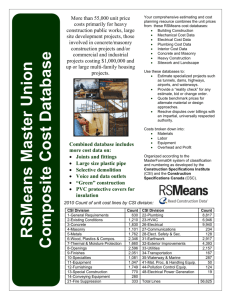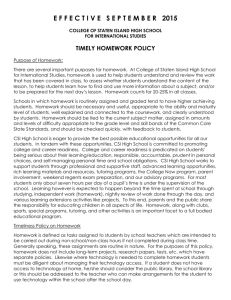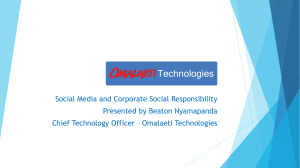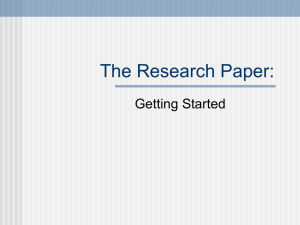csi professionals briefing 2014
advertisement
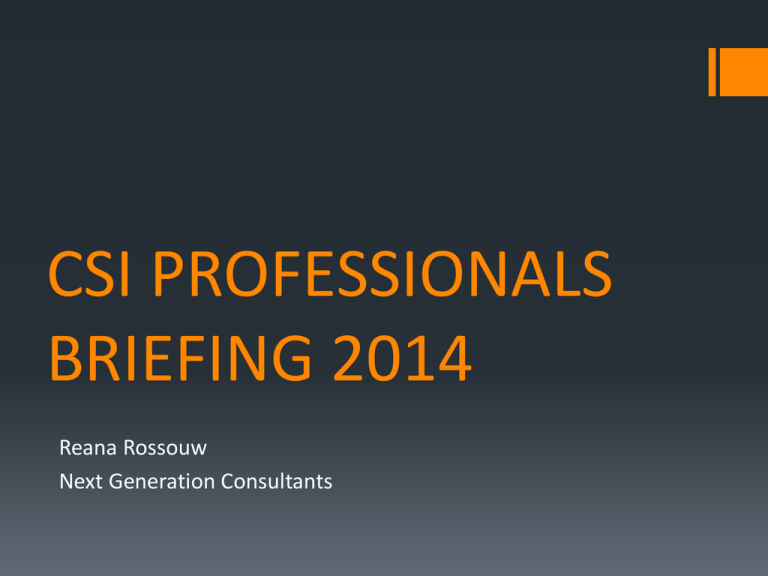
CSI PROFESSIONALS BRIEFING 2014 Reana Rossouw Next Generation Consultants Session One: Trends and Forecasts 2014 Our Vision: Increasing Impact and Enhancing Value Our Objective: We want to know how to cultivate change more effectively in a world that sorely needs it Our context Compare practice globally: US, Europe, Far East Africa (continental) South Africa (regional) Benchmark against findings of our Impact Investment Index Tracking for the past ten years Supported by 45 personal interviews with industry practitioners What we know: CSI has become more strategic but may need to become more than that - CATALYTIC Too little progress has been made while the problems we face continue to grow We believe that the work of the next ten years will have to build on existing efforts to include an additional focus on coordination and adaptation Barriers to change Independence and control Insularity and inward focus Caution and risk aversion Time and inertia Competition and credit The end result: A system with no natural mechanism for coordinating effort, for learning, for sharing knowledge about what does and does not work, or for adapting to shifting changes Isolated successes that are seldom replicated, new innovations that replaced old ones before they had time to prove themselves, with the unfortunate end result that funders and their beneficiaries are doomed to repeat the same mistakes again and again 1. A brave new world Bigger Understand the context Pick the right tools Align independent action Activate networks Leverage other’s resources Better Know what works (not) Keep pace with change Open up to new inputs/ideas Share by default Take smart risks Evidence: Industry collaboration (National Collaboration Trust on Education); specific forums for specific focus areas (beyond painting class rooms and the OVC forum) – Western Cape Donor’s Forum) 2. Flipsides of the coin Government in crises Strains on safety nets Collapsing service delivery Weakened social support structures Sharpened eye on non profit performance Rising funder/NGO tensions Continued legislative reforms Intense media and public scrutiny Forced collaborations and mergers Increasing social activism and violence Increased expenditure on CSI Increased public participation in giving More innovation in development approaches Changing funding models New localism Volunteerism rising and increasing Increased communication on giving Evidence: Increased income disparity vs. increased quality of life 3. Lean and Mean Impact of the recession: Effective Efficient Strategic Less is more Less is less Outcome of the recession: Impersonal Hands-off Elusive Exclusive Abusive Evidence: Website submissions only – no personal contact – no appointments – automated responses. More CSI brochures are being printed and distributed than ever before, sustainability reports on average has 4 pages dedicated to CSI SPENT! Without a single/person/number/contact/e-mail! 4. War on Ideas My flagship is better/bigger/more expensive than yours Fewer programs Bigger programs Higher profile programs More strategic programs More exclusive programs More internal programs Evidence: Most flagship programs are single donor interventions – on average lasts for 2 years – closely linked to brands – with multimedia advertising support – no communication about impact – fly by night perception! Unilever – ‘saving life’s’ - not selling soap (Lifebuoy) Capitec – SWOP Mall – conscious consumerism – recycle, upcycle – on trend 5. The next big thing Capacity and leadership development Operating support Enterprise development Job creation Good news: Collaboration is evident Bad news: NGO’s are being measured on HOW they spend money not the results they achieve Focus shift from social to socio economic development Evidence: Good News: Sponsoring NGO’s for industry events. Prepared to pay on average 10% operating support. Bad News: It costs on average R1m to create a single job or start a new enterprise. 6. Green (BLUE) is the new black Environmental programs Impact from operations Impact of climate change Risk issues and impact issues Short term issues Future issues Food security Water scarcity Income/job disparity – waste/recycling Evidence: BHP Billiton offsetting 60 tonnes of carbon through the Wildlands Trust: Question: Is carbon offsetting a social issue / operational issue / risk mitigating issue? Is building a clinic the result of negative environmental or health impact on communities (LTO) – risk mitigating strategy or CSI spend or infrastructure / local economic development? 7. Alphabet Soup BBBEE LTO GRI IIRC IPIECA ICMM ISO26000 KINGIII UNGC SLP SED PRI IFC OECD Impact of governance and compliance: More due diligence: Indicators to measure change Impact – anecdotal evidence Assurance – more paperwork Reporting – evaluation requires pictures for reports New policies, codes of conduct and strategies Evidence: More reporting does not mean necessarily mean better reporting – Practitioners will have to come to grips with the impact of governance, legislation and reporting requirements AND have their work assured. 8. New Age Stuff Social and ethics committees Stakeholder engagement Community perception surveys Human rights implications Social audits Baseline studies Risk and opportunity studies Impact studies Beneficiation New reports - Board committees oversight New reporting lines - Corporate Affairs New titles – Community Relations practitioners, community engagement practitioners, community liaison officers New responsibilities – human rights audits in programs New strategies – linking to and integrating with NDP, IDP, SLP New focus areas – industry commitments New criteria – ethics policies, vendor registration processes, sustainability credentials (water, energy, labour practices, ethics policies) Evidence: Signatories to local and international guidelines and codes (ICMM and IPIECA) – global policies, local execution. Major impact for companies moving into Africa 9. Hindsight is perfect sight Spectacular failure Spectacular success Glimpses of brilliance Theory of change Theory vs. practice Process vs. systems Outsurance - Pointsmen Dial Direct – Pothole Brigade Healthcare workers Discovery Mama’s - Clover Holistic development Cradle to grave development Lifecycle development Lifestage development Evidence: Previously criticized (low profile) programs have become ‘unmissable’ solutions to social problems – Biggest success stories? Single focus area and program! 10. Dangerous half truths What's good for you may be bad for them What's bad for them maybe good for you Poverty has many dimensions Poverty alleviation or eradication Development is hard work Development is complex Development is expensive Development is systemic and systematic Development takes time Evidence: Most programs have only short term and quantitative impact – sustainability remains an oxymoron – development requires more than 12 month single cycle/single donor interventions – pass rates is not necessarily an indication your program worked! 11. 1 to 100 in 10 seconds The numbers game Jobs Pass rates Books Classes Students Learners Teachers Quantitative vs. qualitative impact Negative vs. positive impact Intended vs. unintended impact Short term impact vs. long term impact Evidence: Sustainability reports only focus on quantitative data – not aligned to reporting requirements – and no single report speaks about qualitative impact = actual change. No single integrated report is able to show the link between community relations and value creation 12. Dichotomies Urgency for short term results and stamina for the long term Holding on to autonomy and looking for opportunities to coordinate and collaborate Insisting on rigor and taking risks despite uncertainties Innovation and creativity Responsiveness and responsibility Scalability and focus Replicability and results Evidence: Results of CSI reputation surveys indicated that only 10 companies in the whole country is getting it right! No new corporates on the top 10 list for 10 years running! 13. Keeping up with the Jones’s Asset-based funding Seed funding For profit funding Social enterprises and social entrepreneurs Market-based solutions Impact investment Collective funding Cause related funding New words: Resilience Empowerment Capacitating Old words: Sustainability – sustainable development = no one knows what it means or how to do it or how to prove it Evidence: Only one in 20 funders will consider new funding approaches over the next two years. Only one in 30 funders will consider changing their funding criteria within the next 2 years. 14. Volunteerism is cool Growth in volunteerism Everyone is a hero Everyone can make a difference Everyone wants to make a difference Employee engagement is the latest and coolest new tool in the box It starts with me It is all about me Rewarding volunteerism Evidence: One in three corporates now have some form of facilitated employee volunteer program – and one in five have a dedicated practitioner to volunteerism. One in two corporates reward volunteerism! 15. Please give that man a fish Give a man a fish… Give a man a rod… Educate a women and you …. Cash is no longer king Education is no longer cool HIV is no longer an issue Babies are more sustainable than old people Cost benefit analysis is the new thing Sustainability of fishing sources Endangered fish on the red list Impact of climate change on fishing industry Fishing licenses All the kings horses and all the kings men could not save NEMO Question: What happens after the fish is caught? Give a man a fish and feed him for a day; teach a man to fish and you feed him for a life time; show him how to use Google search and he can teach himself how to fish! 16. I know what you did last summer Unlikely bedfellows NUMSA, EFF, AMCU Righttoknow Solidarity Benchmarks and Lonmin Community activism is on the up Community activism may affect you negatively Community activism may destroy your legacy Burning down of schools and libraries, clinics Evidence: Funding of political parties, funding of political leaders, funding of trade unions, funding of advocacy groups – what you report, where you report, do you read your own company’s sustainability/integrated reports, when last did you scan the media for information about your company? 17. Local is lekker – Joe & Jane Soap Urban vs. rural funding The new donor/philanthropist = Joe Soap Local Hero’s (volunteers) (Not) In my back yard Giving without boarders (Zimbabwe and diaspora) Crowdsourcing Local food gardens / markets / produce Local recycling Local products Request from ordinary citizens (not a formal NGO) who are the new facilitators and fundraisers Evidence: Communities are organizing themselves: But no-one remembers who gave them the hand up! Khayalitsha cookies, Mielies, Men at the Side of the Road, Shanduka, Changemakers, Santa’s boxes, Kylie Mycroft, Claire Reed 18. Status Quo is not an option Investment = Return Responsive = Proactive Needs focused = Outcomes focused Transaction based = Relationship based Organisational funding = Issue funding Cash giving = Value chain integration Management = Leadership Most companies have some form of M&E Only one in ten companies conduct some form of impact study Less than half of companies record the number of beneficiaries Less than 20% of companies do baseline studies Evidence: Becoming more strategic does not necessarily mean you have increased impact. Poorest regions still gets the least funding, national programs does not mean national impact. Companies moving into Africa (30% of all corporates) – uses the same strategy, focus areas, process, methodology as in South Africa. 19. A horse, a horse, my kingdom for a horse Shared value & shared risk Risk vs. impact Ethics, morals, values The elusive sustainability point Disaster relief vs. infrastructure Minority vs. majority funding Gender based funding Old vs. young Jobs vs. food Books vs. labs Urban vs. rural Crime vs. rehabilitation Art vs. houses Evidence: Strategies have not become diversified – but focus areas have. Strategic CSI needs to re-invent itself – it is not about MORE of the SAME. Neither is it about doing MORE with LESS. Look out for the new word – not STRATEGIC CSI – But CATALYTIC CSI 20. Two hills ahead The pressure to measure What you know What you don’t know What you don’t know you don’t know Are you sure you want to know? Doing what matters Doing what is right Doing it the right way Accountability Flexibility Authenticity Engaged Engage widely Research deeply Compare extensively Collaborate creatively Communicate honestly Innovate flexibly Question: Towards Best Practice – what will it take? WHO is getting it right – Nedbank Foundation, FirstRand Group (FNB, RMB, Wesbank & Firstrand Foundation) Evidence: Homegrown best practice: Global Awards – Transnet Phelophepa and BHP Billiton Treepreneur Project Advice for the Future Trap Number 1: Once we have figured out the business model and strategy, we don’t need to worry about it anymore! Trap Number 2: Grow, baby, grow! Trap Number 3: If it worked for them, it will work for us! Align for Success - In figuring out the right roles and resource priorities, the biggest challenge for many community foundations is aligning values, strategic priorities, business model choices, and organizational culture. Adapt to Thrive - Community practitioners will always be challenged to adapt to serve an ever-changing set of community and donor priorities, focusing on impact today and permanence as an enduring community resource. Questions and Discussion What did we miss? Examples of your own practice? What will it take? What do we need to do? Contact Reana Rossouw Next Generation Consultants - Specialists in Development E-mail: rrossouw@nextgeneration.co.za Web: www.nextgeneration.co.za PLEASE NOTE: THIS PRESENTATION IS PART OF A LARGER BODY OF RESEARCH! THIS INFORMATION IS COPYWRITED AND THE INTELLECTUAL PROPERTY OF NEXT GENERATION CONSULTANTS.
